|
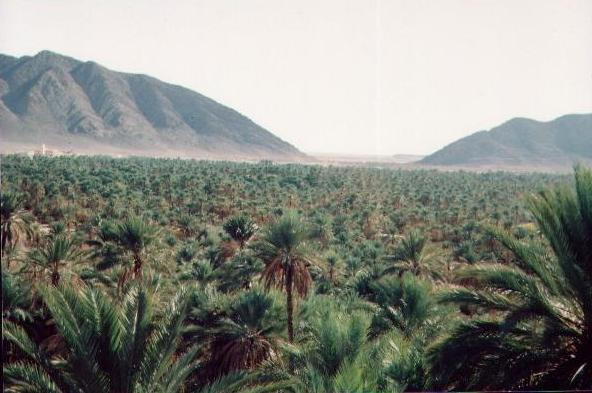
Beyond Figig
Abdurrazzak Ajaja
Email: A. Ajaja
Web: ajaja.ca
Montreal, Quebec, Canada
December 15, 2006.
|
|
|
Mountains, date palms, pure air and calmness are still present here. They
are the old main things that they have never been changed.
It was a time when At-Ufiyyay (Figig's people) were living in their own, and the
land was very thriving as it says the idiom "Beyond Figig". This time is over.
Between palm trees, others fruits and vegetables were planted. Food came from Iyran (garden). Each
family bred a little herd sheep in house to provide milk and meat.
Little boys were already productive by helping parents to accomplish some tasks. Everyone had
a role and everything had a meaning.
| |
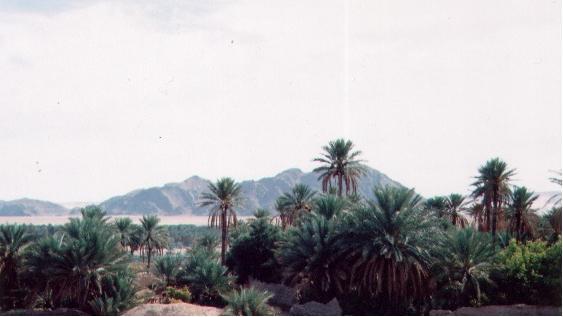
|
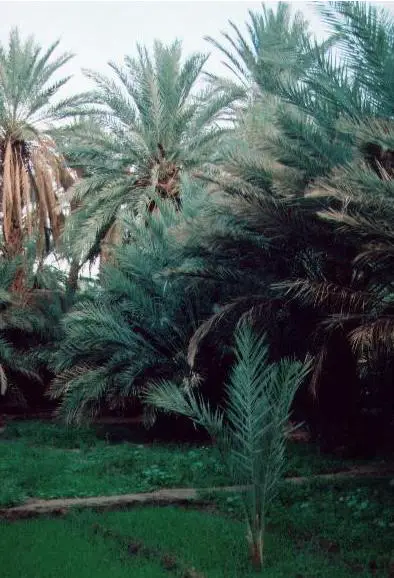
|
|
This is an Iyraan (garden) named Maamar Ukudi; almost well kept. The
date palm (Tazdayt, plural Tizdayin) is chiefly Aziza. Some Al-Asyan and Tigharasin are
planted here as well. It is irrigated by nine (9) Tghirin (Tighirt
stands for 45 minutes per two weeks) of Ali-w-Aamar ifli (water from its source).
From little Iyranat; came dates, fruits and vegetables for people. Grass, weed
and lucerne were used to feed the in-house herd sheep. Manure was transported
on the donkey's back to Iyranat in order to fertilize garden soil.
No garbage! everything is recycled.
|
In the near surroundings, the soil was used to sow
wheat (Tasharza). This completed the necessary needs we had in order to live
decently.
To gain more space to cultivate, we built Tidunawin (walls with stones and
soil) over the Jorf. The private property of each owner is shown by Timusagh
(built with soil). Trespassing was not allowed and unthinkable anyway.
| |
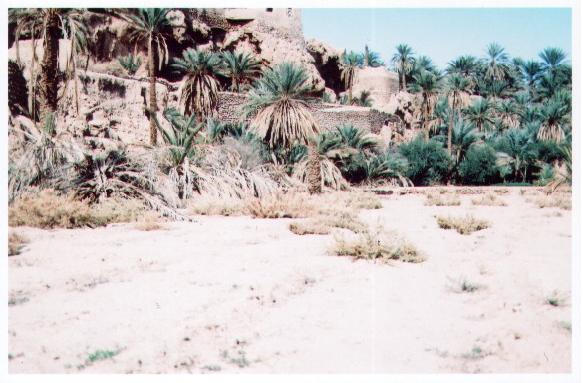
|
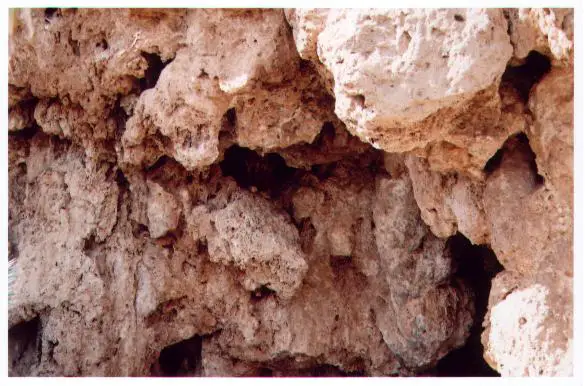
|
|
Jorf, sort of a salt mountain is about 1 kilometer long and 50 meters
high. It is often the favorite place for pigeons and bees to take nests; scorpions
and snakes as well.
It belongs to At-Lamiiz, At-Sliman and Iznayen. It is a line
between high-Figig and low-Figig. Taanount, Alaakbat and Azru are
the principal ways between them.
In the north of the
high-Figig region, just some meters after the pass which is the
main entrance to Figig, all of the Tittawin (the water sources)
of Iflan are there. Digging only 10 meters could lead to water.
|
To conduct Aman (water) from Tit (source) to Iyran, the
system Ifli (Plural Iflan) is used. That is water that comes the long of
Lakbawat (underground channels); then in Tiragwin (Targa stands for channel).
Irrigate a little Iyran needs some Tighirin. But if it comes for someone to
Kan (close) water at night or if someone prefers to postpone irrigation,
Shwaraj (Sharij stands for basin) are the essential place to store water.
It is built with stones and cement (lime before).
In the most cases, the owners of Tanita (12 hours/ 2 weeks) of water own a water
basin. A Sharij is also used as a swimming pool for kids; if they have
permission to swim, of course.
| |
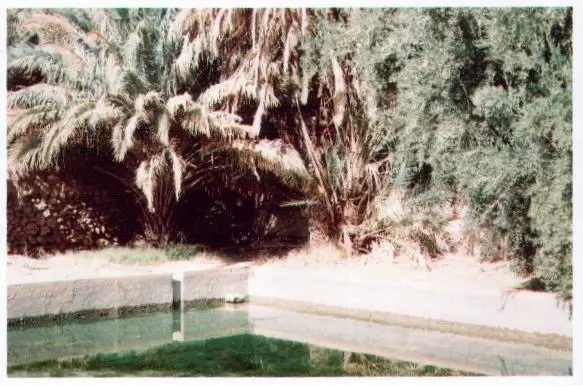
|

|
|
Big or small, the crop must go to Tiddart (house); especially dates
have to be compressed in Tikhuby (big containers made with burnt soil)
in order to stay fresh during a whole year until the new ones are harvested.
Figig is a set of seven different communities. They are: At-Wadday,
At-Amar, At-Lamiz, At-Sliman, At-Nnaj, At-Addi, Iznayen. A territory of a
community is called Aghram (plural Igharmawan) that is a fortified group of
houses.
Near the entrance of each Aghram, rose a tower (Tazakka Ntrasiyt) where someone
was keeping watch on the surroundings, in order to protect Aghram. Big doors on the
main entrances were used to be closed at night. Engineering of Aghram is designed as
a maze in order to have only few entrances.
|
The presence of the French in Figig from 1904 to 1956 had some
influences in the life of AtUfyyay. Tower haven't their roles
any more. To settle an issue, from now on, the place where
to be is Lbiru (Bureau) which is set in the middle of Figig, over
the Jorf, where the main church still takes place.
This French new and stern administration decided everything and ruled
the roost. Minds have changed. People bequeathed their decisions to the
Irumian, the french new comers; the hard hearts.
Once pulled out, The French succeeded to leave entangled dependence.
| |

|

|
|
Akharbish (School), often was held near a mosque, the place where one learns
Lkuraan (Kuran), has not been the trend since the arrival of the
French. The tendency is to go to a modern french school where one
can learn French language; the Jean De Lafontaine fables.
Speaking Tmazight, at the age of seven, entering a school for the
first time to learn French and Arabic; compelled pupils to deal with
three languages at the same time. Big challenge!
The wanted circumstances have made the fact that learning French was, and still is,
the straight way to earn notoriety and prestige. Akharbish collapsed and Arabic
language lags behind.
|
Inside of an Aghram, the way (Abrid) is a sort of circuit that
lead to the main entrances. Some houses were extended by building rooms over
the way. The related part of the way becomes a hall (Askif. The feminine word Taskift
is the place where to store human manure).
Houses (Tidriwin) are built with soil mainly. Two essential parts of a date
palm are used to make a roof (Tizidin: Fourth part of its trunk cut in height)
and Tikachba (head of its leaf called Taratta, plural Tiradwin).
The structure of Igharmawan remains the same even
though electricity, water, new windows and doors have been added and changed.
| |
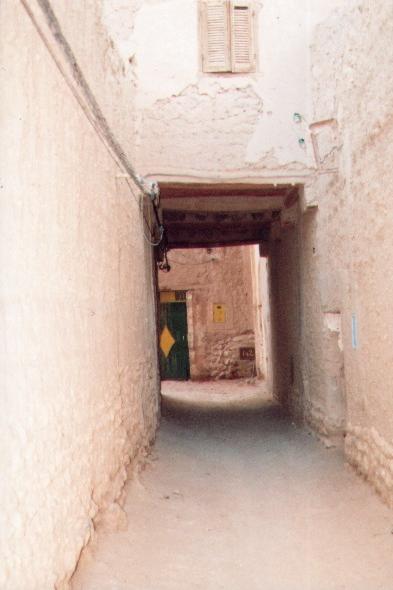
|
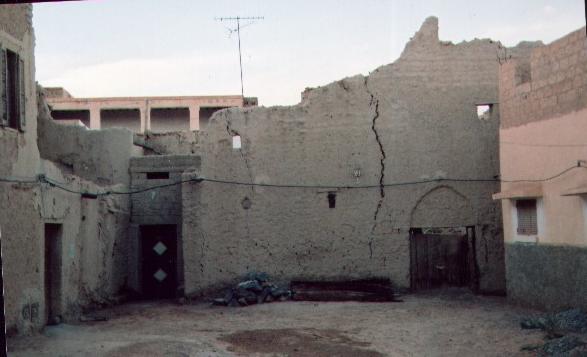
|
|
We can find some squares inside Aghram. They are a kind of places
that were used to make gatherings or to exhibit merchandise (chiefly Udi:
cooked butter, Ibrassa: dried milk, and Douft: sheep wool) brought
by arab nomads coming from the surroundings .
This time is now over. Even some parts of houses were rebuilt in cement,
Aghram is no longer the same, not well-stocked as before. The remained people
want more space; something new outside Aghram. The administration
formed by sixteen men (At-Sataash) of each Aghram were in charge to sell lands.
People took the advantage of low prices to build a kind of ranches of three
hundred kilometer square, in average.
|
The materials used to build houses were taken from
the land itself, that is what it was available. Walls and pillars (Ssiriyat)
are made with soil; roofs with the parts of the date palms covered with
soil. In the more cases, houses are duplexes. Windows were not set inside
or outside houses; just kiwat (little opening). Indoors, there was always a
place to feed a sheep. The richest people had also one or two cows; and
a donkey (Aghyul, Plural Ighyal), which was the essential means of transport
to Iyran. All was in equilibrium and in harmony.
At-Ufiyyay have left Aghram to leave outside; leaving behind
them an Aghram that is falling in desolate ruins.
| |
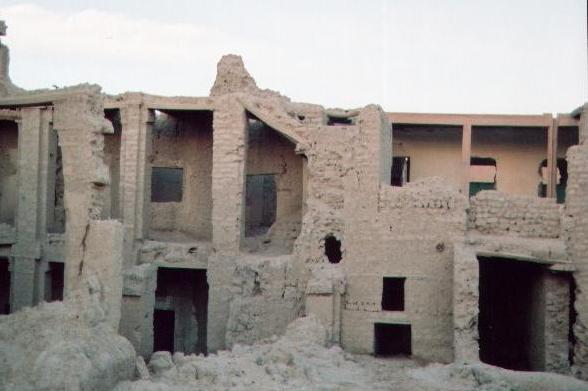
|
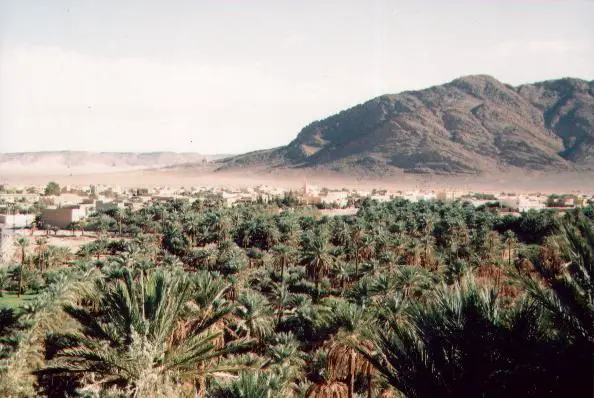
|
|
They are still, nevertheless, some houses inhabited inside Aghram by
Aaraban (arabs) coming from the surroundings. Most of them became Ikhammassan
(farmers taking the fifth part of the crop) trying to do their best.
There are two main At-Ufiyyay classes:
The first is the retired people
from Europe (France essentially) who have the means to build new
and modern houses (ranches) outside the fortifications and even to dig wells to
irrigate Iyranat; just for some dates and for the sake of it. The steady
income they deserve maintains their mind at rest.
The second class is our generation, their children who left Aghram
and Ifiyyay; and even the country. Young UFiyyay is very scarce in Figig.
|
Thanks to the progress, we built new houses with cement and
steel. Indoors, electricity, gas, phone, and especially cell phone,
miscellaneous and multitude digital satellite
programs, and even high speed Internet are available.
The satellite programs are the principal source to stay abreast of news around
the world. Internet is not a buzz word any more. It is a reliable window toward other
realities. For the remaining young in Ajanna (High Figig), the only cyber shop,
near LBiru, is an on-line software games place and a reliable news desk.
| |
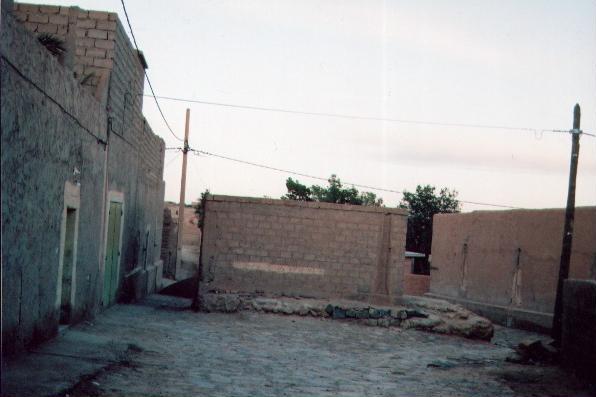
|
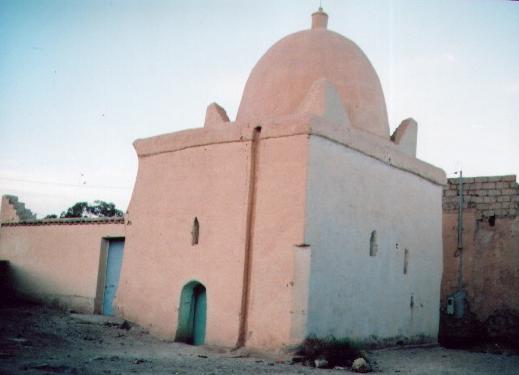
|
|
Something is sure. Our saint scholar predecessors are here
forever. Their domes covering their graves stand. They are blessed for their
belief and for their behavior. They were the guides of our grand parents. We have,
without any doubt, in ourselves, something from them. We are proud of them. Thanks
to them, we can just think that we have learned from them.
|
Meanwhile, AtUfiyyay (Figig Mazigh people) we can find in Figig are
the lucky retirees from France, some administrators and very few
dependent teenagers looking for an escape. The other part of the
inhabitants are Aaraban who come from the surroundings.
The next generation of the new comers will be, seemingly, the new occupants
of Figig. Greetings!
But, when there will be no retiree in Figig, where will tomorrow’s
funding come from?
| |
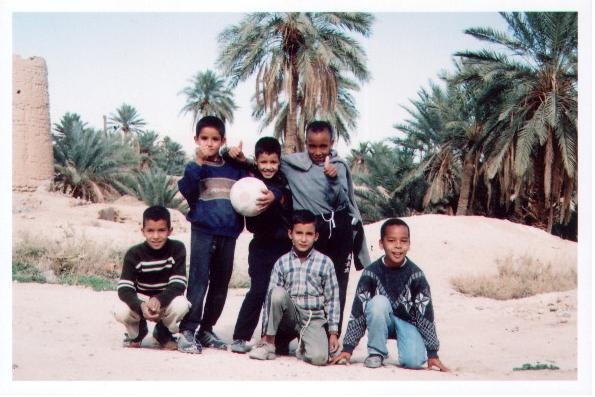
|

|
|
Khalid is a young Ufiyyey. He has earned his Bachelor's Degree in Law . Rabia is a
young Tufiyyayt. She has earned her College Baccalaureate . Both of them, as many others, are the force
for a virtual nation. Educated and without job, they hope to do like the immigrants; leave Figig and the country.
They are searching for a home where to realize their potential and make their hopes a reality. The dream,
which is fulfilled for others when things were straightforward, is to immigrate to Europe and North America.
As they are neither rich to go to the west countries as investors or as phony students to become
resident thereafter; nor have a job to get a famous visa or go stowaway and vanish somewhere, nor
have abroad someone to get married to; winning the lottery to Maryland, USA; they really hope so!
|
|